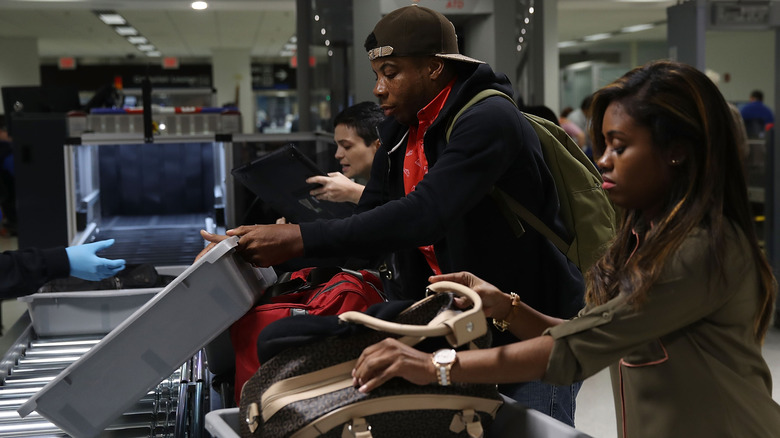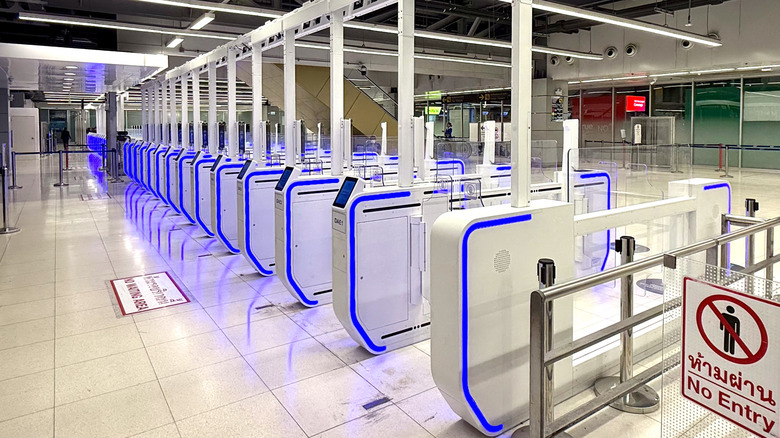TSA's Hi-Tech Automated Screening Lanes Are Safer And Faster. Here Are The US Airports That Have Them
Anyone who's traveled through an airport post-9/11 knows the misery of dealing with airport security. You've got employees barking what to do, the excruciating 100-milliliter liquid container rule, separate conveyor belt bins for laptops, you're forced to expose your smelly socks to the world, and, of course, there's the body scan and pat-down. Even certain types of clothing can get you flagged during a TSA screening. This is why it's good that some airports in the U.S. have finally started making things easier for stressed travelers. Welcome to the TSA's automated screening lanes, available in New York, Los Angeles, Las Vegas, Dallas, Chicago, Minneapolis, Miami, Houston, Newark, Seattle, Atlanta, New Orleans, and Baltimore airports.
In a nutshell, automated screening lanes (dubbed "ASLs") improve the part of security where your stuff passes through the CT scanners. They provide four bin-loading slots per lane rather than one, and the rollers turn automatically. Luggage and other items get shuffled off to the side automatically if there's a no-no item in your bag, like aluminum foil, and the bins themselves are 25% larger than before. On the software side, TSA officials can also now rotate the CT scan images to get a better view of what's inside your bags, thus increasing the safety check's efficiency and accuracy.
While it's unrealistic to think that such improvements will grant you an easy-breezy-cheery airport security experience, ASLs ought to at least improve safety while making your time in the queue more tolerable. But don't rely on them to get you to your plane more quickly; it's a smart idea to give yourself the same amount of time as usual.
What to expect from automated screening lanes
So if U.S. airports in New York, Los Angeles, Las Vegas, Dallas, Chicago, Minneapolis, Miami, Houston, Newark, Seattle, Atlanta, New Orleans, and Baltimore implemented automated security lanes (ASLs), then the problem's solved, right? Not quite. Even if you're using one or more of these airports, there are caveats.
New York City, for example, has three airports — JFK, LaGuardia, and Newark — but the automated security lanes don't apply to all terminals in all three airports. JFK added ASLs in 2017, but at that time, they were only in a few lanes in Terminal 4. Newark got 17 ASLs that same year, but only in Terminal C – though any upgrades at all might mitigate Newark's double-the-average rate of TSA complaints. LAX in Los Angeles finished installing ASLs in 2018, but only in 14 out of 16 security lanes in the Tom Bradley International Terminal (TBIT). There were more ASLs installed in terminals 2, 3, 4, and 7, but it's still unclear how many.
These few examples illustrate the bigger point: even if you pass through an airport that has automated screening lanes, the ASL rollout has been staggered and not universal. Plus, reporting on ASLs has been inconsistent. This is why it's best to not assume that you're going to use an automated lane just because you're passing through an airport that has them. Err on the side of caution, plan to be using the old security lanes, and give yourself the same amount of time as usual. If you really want to dig further, you can try and find information on the specific terminal that you're assigned for your flight to see if it uses ASLs.
The slow path to a smoother airport experience
It's taken decades for airport security to improve following the airport security clampdown after 9/11. The TSA knows it, too. The attitude on the TSA's website is downright playful about this, with headers like "Summer Blockbuster — Automated Screening Lanes coming to an airport near you." It might not be enough to ameliorate decades of annoyances, but if we're being charitable, perhaps it does mark a change in the right direction. It's true that things would be slower, less safe, and less efficient without at least some automated screening lanes across various U.S. airports.
That being said, the U.S. is late to the party. Singapore's cutting-edge and gorgeous Changi Airport implemented less cumbersome security measures back in 2004. You used to be able to carry full bottles of water through security at Amsterdam's Schiphol Airport until September 2024, when that changed because of increased geopolitical threats within and around the EU. Other airports, like Milan Malpensa Airport in Italy and Melbourne Airport in Australia, have less strict liquid rules. At Shannon Airport in Ireland, you can at least put the 100-milliliter bottles in your carry-on or backpack and not in a separate, transparent plastic bag. Thailand's Suvarnabhumi Airport, meanwhile, introduced automatic departure gates in 2023, like many airports before it.
The U.S. Department of Homeland Security does have plans for similar, and even more advanced, airport security and processing procedures but there's no word on when these will go into effect. So for now, enjoy the automated screening lanes when and if you can, and have a safe and happy trip.


